Navy 14, Army 0 Nov. 30, 1940 – Philadelphia, Pa.
Navy celebrated the 50th anniversary of the Army-Navy game with a solid, all-around effort, resulting in a 14-0 triumph. Navy scored on its first drive, as Bill Busik went the final-two yards for the touchdown to make it 7-0. The Midshipmen covered 54 yards in 12 plays, with Busik accounting for 50 of those 54 yards. Although the Army offense could muster just 107 yards of total offense on the afternoon, the Cadet defense held Navy without a point on its next-two drives, which were halted deep in Army territory. However, the Midshipmen tallied their final score in the third quarter when Howie Clark tossed a nine-yard touchdown pass to Everett Malcolm.

–
–
Navy 14, Army 6 Nov. 29, 1941 – Philadelphia, Pa.
As a Naval Academy player from 1919-21, Swede Larson never lost to Army. And in his first-two years as head coach, his teams shut out the Cadets by a combined score of 24-0. But prior to the 1941 Army-Navy contest, the Marine major was informed he was being sent to the Naval War College in Newport, R.I., immediately after the football season. As you can imagine, he wanted nothing more than a final victory over Army, which is why he was less than pleased when his club trailed West Point, 6-0, at halftime. Challenging his team to win its last battle on the football field, the Midshipmen answered the call in the second half. Bill Busik’s effective running and passing set up touchdowns by Phil Hurt and Howie Clark, which led to a 14-6 Navy win.
–

–

–

–


Col Blaik’s Teams were to lose to Navy in 42 & 43 before Army would win 4 straight.
–
–
Navy 14, Army 0 Nov. 28, 1942 – Annapolis, Md.
In an effort to conserve transportation resources due to World War II, the Army-Navy game was moved to Annapolis in 1942 and West Point for 1943. This meant the West Point Corp of Cadets, with the exception of two cheerleaders, would not be permitted to attend the game, nor would anyone else outside a 10-mile radius of the Maryland state capital. Thus, half of the Brigade of Midshipmen would serve as the Army cheering section, while the other half would root for the Mids. As it turns out, the Cadets would need much more help than this, as Navy turned back Army, 14-0. Backup halfback Joe Sullivan opened the scoring with a short touchdown run in the second quarter. Hillis Hume set up the other touchdown with an interception deep in Cadet territory midway through the third stanza. Hal Hamberg proceeded to hit Ben Martin with an 18-yard scoring strike. Hume clinched the win with another interception of Army quarterback Doug Kenna at the Navy seven-yard line.

–
no film of the stateside game – meanwhile there was a war on! but overseas – a “not your average” Army – Navy game took place –
–
Navy 13, Army 0 Nov. 27, 1943 – West Point, N.Y.
For the first time in 50 years, West Point, N.Y., played host to an Army-Navy game. The Midshipmen were less than gracious guests on the field, however, scoring two touchdowns in the second half of a 13-0 triumph. In the first half, Army got inside the Navy 40-yard line three times but failed to reach the end zone. Navy finally cracked the scoreboard midway through the third quarter when Bob Jenkins capped a 42-yard drive with a one-yard touchdown run. Jim Pettit then contributed two of the game’s biggest plays, one on each side of the ball. His one-yard touchdown run stretched the lead to 13-0, and he halted an Army drive at the Navy 24 when he intercepted Doug Kenna’s pass.


–
–
Army 23, Navy 7 Dec. 2, 1944 – Baltimore, Md.
Two weeks prior to the 1944 Army-Navy game, President Franklin D. Roosevelt announced the contest would be moved from Annapolis to Baltimore as part of the “Sixth War Bond Drive.” The U.S. Treasury Department designated 20,000 seats as War Bond Seats. In other words, buy a war bond and get a free ticket to the game. The arrangement not only generated $58.6 million in war bonds, but also allowed 70,000 fans to see a 23-7 Army win. “Dale Hall” put Army on the scoreboard with a 20-yard touchdown run, and Joe Stanowicz’s blocked punt in the end zone stretched the lead to 9-0 in the third quarter. Clyde Scott’s one-yard touchdown run cut the deficit to 9-7, but “Mr. Inside,” “Doc Blanchard”, and “Mr. Outside,” “Glenn Davis”, each scored fourth-quarter touchdowns to put the game out of reach. The 9-0 Cadets closed the fall atop the Associated Press poll, while 6-3 Navy finished fourth.

ArmyFB_1944_vsNavy_PalmBeachPost_Dec31944
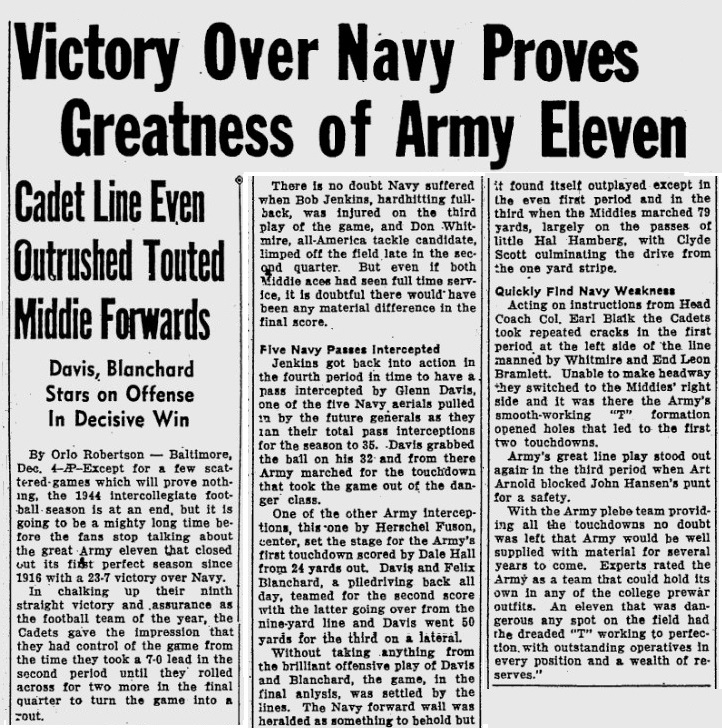
ArmyFB_1944_vsNavy_EveningIndependent_Dec41944

ArmyFB_1944_vsNavy_PrescottEveningCourier_Dec71944
–
–
–
Army 32, Navy 13 Dec. 1, 1945 – Philadelphia, Pa.
Navy entered the 1945 season finale toting a 7-0-1 record. The No. 2 Midshipmen defense opened the season with three-consecutive shutouts and had never allowed more than one touchdown in any of the following five contests. However, it hadn’t played an offense as potent as No. 1 Army, who posted a decisive 32-13 win. Felix “Doc Blanchard” caught the attention of the Heisman Trophy voters, who awarded the Army halfback with the honor days after his three-touchdown performance. The Cadets jumped out to a 20-0 lead, and the Mids were unable to recover. They scored their first touchdown on a 39-yard Bruce Smith-to-Clyde Scott touchdown to cut the halftime deficit to 20-7. Blanchard erased any hope of a Navy comeback when he intercepted Smith’s pass and returned it 52 yards for his last touchdown of the game. Smith returned the favor by intercepting a “Glenn Davis” pass to set up Navy’s second touchdown, a Joe Bartos three-yard plunge. Finally, Davis atoned for his aerial miscue by scampering 28 yards for the final score to give Army the win and eventual national title.
–

–

–

–

–

–
couldnt find a A-N 45 hilite – but here is an intersting film on the 1945 team in training
–
Army 21, Navy 18 Nov. 30, 1946 – Philadelphia, Pa.
After finishing second in the final 1945 AP poll, Navy endured the other end of the spectrum in 1946. With just eight returning lettermen, Navy struggled to a 1-8 campaign. While these eight losses included a 21-18 defeat at the hands of rival Army, it was the Cadets who held the short end of the stick when all was said and done. Three weeks before its annual grudge match against Navy, No. 2 Army and No. 1 Notre Dame played to a scoreless tie. And while the Cadets would battle the Mids on Nov. 30, the Fighting Irish were set to meet Southern California. Thus, the outcomes on this day were critical to the final AP polls. Down 21-6 at halftime, Navy came back with a pair of touchdowns in the third quarter Bill Hawkins had a two-yard rushing touchdown, and Reaves Baysinger hit Leon Bramlett for a short touchdown to bring the Midshipmen within three points. Unfortunately for the Mids, they were unable to convert on any of the extra points, and the Cadets prevailed. Unfortunately for Army, AP voters took more notice of Notre Dame’s 26-6 victory than they did of Army’s narrow triumph, voting Notre Dame first in the final AP poll.

ArmyFB_1946_vsNavy_MilwaukeeJournal_Dec11946

ArmyFB_1946_vsNavy_YoungstownVindicator_Dec11946

ArmyFB_1946_vsNavy_SundayMorningStar-Wilmington_Dec11946

Doc Blanchard 1944-46
–
–
–
–
–
–
Army 21, Navy 0 Nov. 29, 1947 – Philadelphia, Pa.
In front of 103,000 fans, including President Harry S. Truman, Army scored one touchdown in each of the first-three quarters to cruise to a 21-0 victory over Navy. A Bill Hawkins fumble led to Army’s first touchdown, as “Bill Kellum” caught an 18-yard touchdown pass from quarterback Elwyn Rowan. Navy drove right back down the field on the next possession, but turned the ball over on downs inside the Army 10-yard line. On Army’s first play from scrimmage, “Rip Rowan” went around the end and down the field 92 yards for the go-ahead score. He finished the afternoon with 148 yards rushing. ( “Joe Steffy” once asked Col Blaik what his Greatest Thrill was in Coaching — Rip Rowan’s 92 yard run from scrimmage)


ArmyFB_1947_vsNavy_ReadingEagle_Nov301947




Army 21, Navy 21 Nov. 27, 1948 Philadelphia, Pa.
Considering Army entered the 1948 season finale with an 8-0 mark, as opposed to Navy’s 0-8 record, it should not be a surprise that the Cadets were a 20-point favorite. Yet, the Midshipmen proved the oddsmakers wrong by battling Army to a 21-21 tie. Navy quarterback Reaves Baysinger opened the scoring with a two-yard touchdown run midway through the first quarter. However, short touchdown runs by Rudolph Cosentino and Harold Shultz enabled the Cadets to take a 14-7 lead at the half. Navy responded with a one-yard Bill Hawkins touchdown run to tie the game at 14 in the third quarter. Army then took its second lead of the game when quarterback Arnold Galiffa scored on a 10-yard bootleg. Finally, Hawkins preserved the tie with clutch plays on both sides of the ball. He followed a one-yard touchdown run by knocking away a Galiffa pass on fourth down to end the game.

–

ArmyFB_1948_vsNavy_PittsburgPress_Nov281948
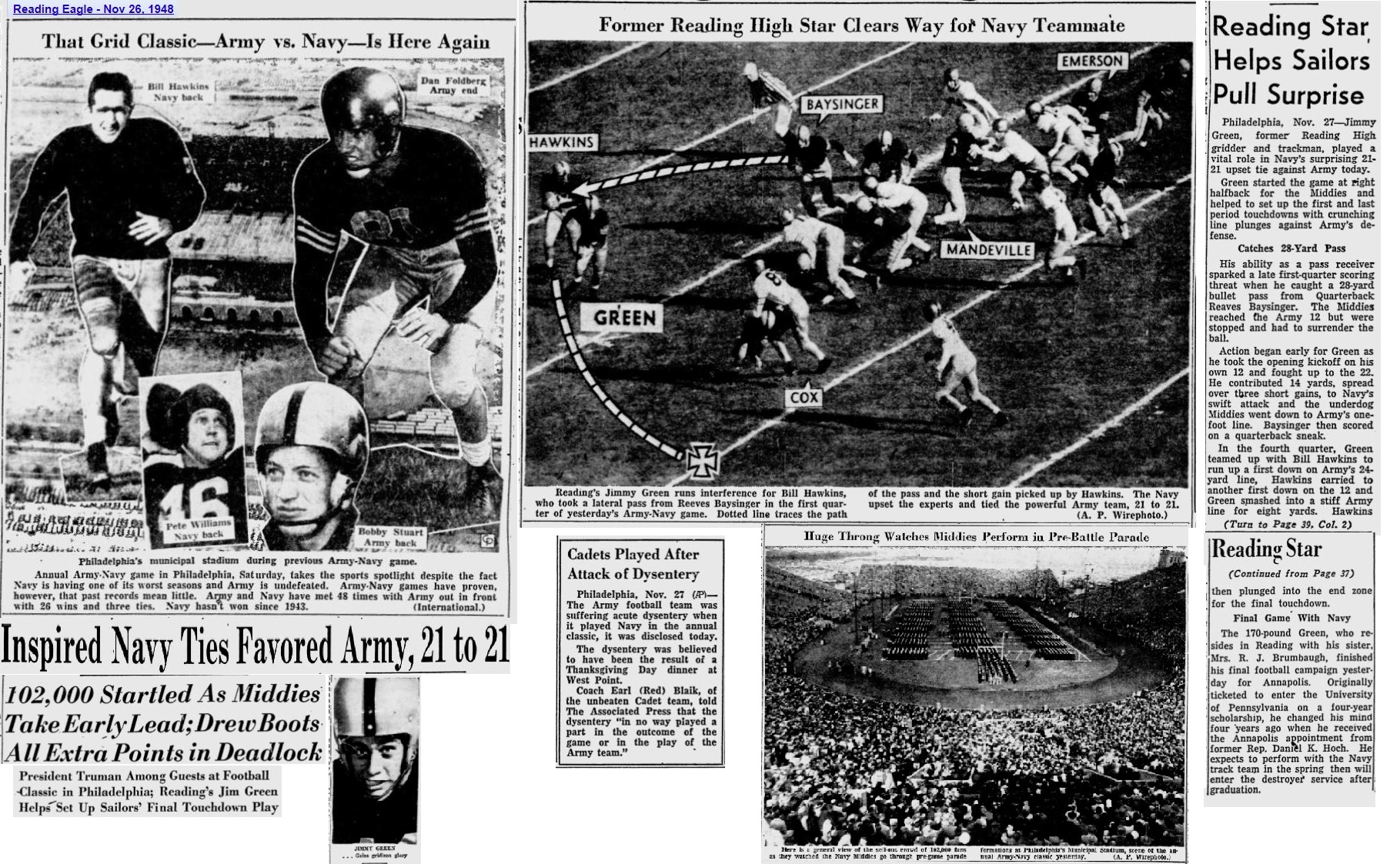
ArmyFB_1948_vsNavy_ReadingEagle_Nov26-281948

ArmyFB_1948_vsNavy_Life_Dec61948
–
Army 38, Navy 0 Nov. 26, 1949 – Philadelphia, Pa.
If Navy had any question about Army’s No. 4 national ranking in 1949, the Cadets erased those doubts with a 38-0 trouncing of the Midshipmen in the 50th meeting between the two academies. The statistics certainly told the story on this afternoon Army had 27 first downs compared to eight for Navy, not to mention a 459-107 advantage in total offensive yardage. The Mids advanced no further than the Army 47-yard line, as Cadet fullback “Gil Stephenson” gained 127 yards on 26 attempts.
–
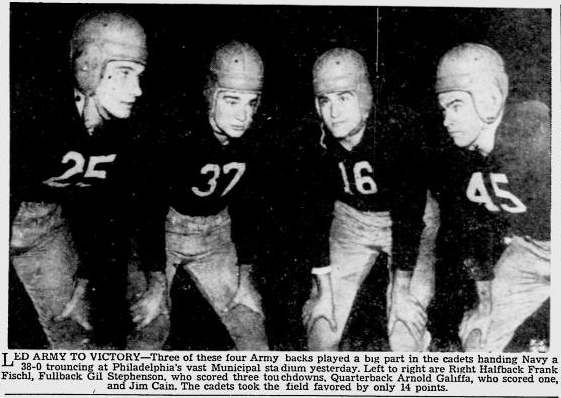
–

–

ArmyFB_1949_vsNavy_TheNewsandCourier_Nov261949

ArmyFB_1949_vsNavy_TheNewsandCourier_Nov271949

ArmyFB_1949_vsNavy_ReadingEagle_Nov271949


–
–
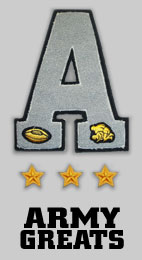



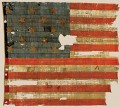
















































































































2 Comments
Hmm it appears like your site ate my first comment (it was extremely long) so I guess I’ll just sum it up what I submitted and say, I’m
thoroughly enjoying your blog. I as well am an aspiring blog blogger
but I’m still new to the whole thing. Do you have any
recommendations for beginner blog writers?
I’d definitely appreciate it.
Pictures – add photos to every thing you list on your site. You can pull material from on line – just comment as to who it belongs to.
One Trackback
[…] when last America proposed to keep an army too small for deterrence. (Navy 14, Army 6. Image via: http://forwhattheygave.com/2013/08/17/1940-1949-army-navy-football/ […]